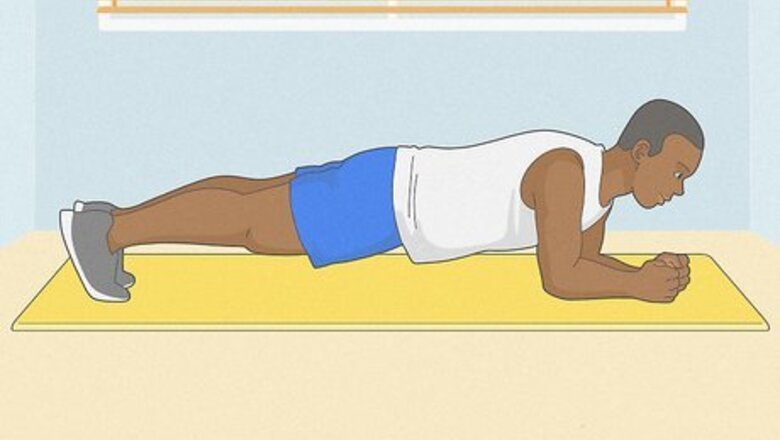
views
- To lose groin fat, do core-strengthening full-body exercises 3-4 days a week, like planks, bicycle crunches, and HIIT workouts.
- Reducing stress and getting better quality sleep at night can keep you energized as well as prevent you from overeating, which will help you lose weight.
- If you're interested in medical procedures, speak to your doctor about liposuction or nonsurgical fat reduction.
Exercises to Lose Pubic Fat
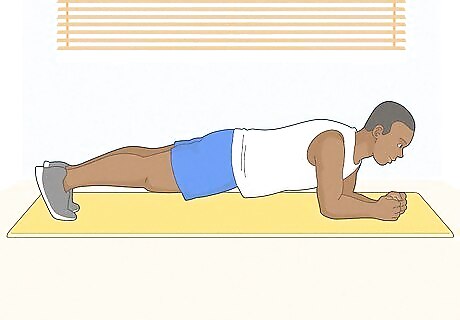
Planks Doing regular planks is a great way to strengthen your core and tone your abs. It’s a classic for a reason: this simple strength-building workout doesn’t require any equipment, and you can do it pretty much anywhere. To do a plank, assume a push-up position: flat on the ground on your stomach, hands flat on the ground by your shoulders. Then lift yourself up on your hands and toes so that your arms are fully extended and your body forms a straight line from head to toe. Hold this position for 30 seconds at a time, then rest for a minute, and then do it again twice more. As you get more used to this position, try maintaining it for longer—even up to 2 minutes.
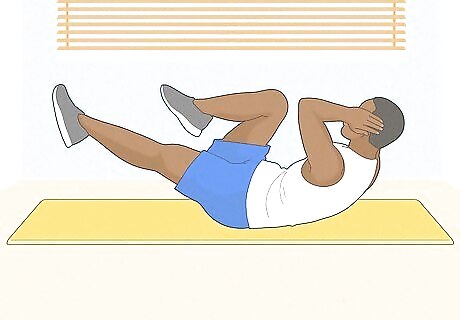
Bicycle crunches While regular crunches can tone your abs, you won’t lose weight there unless you’re getting a solid full-body workout. This is exactly what the bicycle crunch provides: an all-over workout that’ll strengthen your core and help you shed that groin fat. To do a bicycle crunch, lie flat on your back with your legs slightly bent. Place your hands behind your head, raising your shoulders slightly. List your left foot so that it’s about a foot off the floor while extending your left leg to its full length. At the same time, lift your right leg a foot off the ground and bend your right knee until it’s at a 45-degree angle. While you’re making these moves, turn your upper body so that your left elbow meets your right knee and almost touches it for just a second. Repeat this motion with the other side, and continue switching back and forth between legs without stopping until you’ve completed 15 to 20 reps.
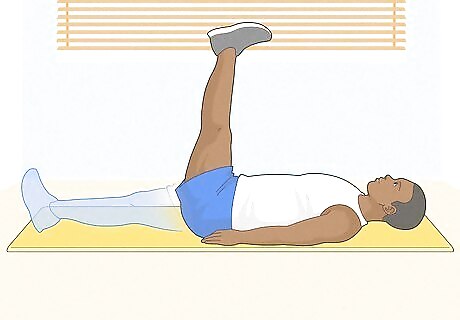
Leg raises Like bicycle crunches, leg raises work your inner ab muscles and strengthen your core, but they also give your legs a mighty fine workout. This is another simple exercise you don’t need any equipment for—just your body, the floor, and a bit of space. To do a leg raise, lie flat on your back, arms at your sides. Keep your legs together and your toes pointed up. Engage your abs as you raise your legs up until they’re perpendicular with the floor, keeping them tightly together while you do this. Try to keep your upper body still as well. Still engaging your abs, slowly bring your feet back down to the floor. Repeat this movement 10 to 20 times.
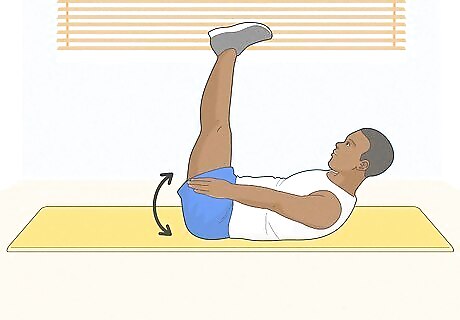
The hundred There are a number of Pilates routines that are super effective at strengthening your core and toning your abs. One of the most popular and effective? The hundred! This move will burn fat and give you a complete full-body workout. To do the hundred, lie flat on your back with your knees bent and feet flat on the floor. Keep your arms outstretched at your sides, parallel to your body. Keeping your legs together, extend your legs and raise them up until your feet are a few feet off the ground. Engage your abs by lifting your upper back and chest. Keeping your knees, upper back, and chest raised, start pumping your arms up and down—arms and fingers still outstretched—about a few inches off the floor each time. Pump your arms 100 times before relaxing for a few seconds. Repeat this set 2 or 3 times if you can.
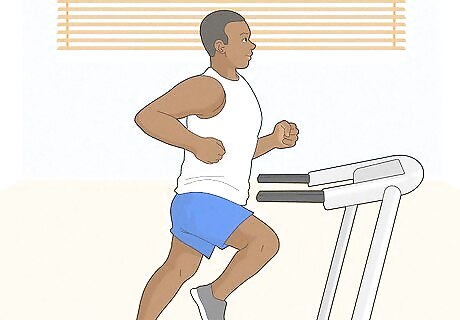
Running While strength training is essential for building your core and toning your abs, a regular cardio routine is also important for helping you lose unwanted pounds. Running is a classic for a reason: it's simple to do, and it gives you a great full-body workout. If you don't run already, you can build up to it by taking a half-hour walk 3 days a week and slowly walking faster and faster until you're walking and jogging at intervals. Keep this up until you're jogging for the entire half hour. Try to jog about 3 days a week for 30 minutes each time, but don't forget to warm up for a few minutes beforehand and stretch afterward.

HIIT HIIT stands for High-Intensity Interval Training, and it refers to a type of workout in which you rotate between short bursts of different aerobic exercises. HIIT workouts are intensive, but they’re short—usually only lasting between 10 and 30 minutes. The different workouts included in a HIIT routine vary, but they often include many of the exercises on this list: planking, burpees, bicycle crunches, push-ups, sprinting, jump-roping, and more. You can take a HIIT class at a local gym, or you can find free HIIT workouts on YouTube. Taking a class offers accountability and can make working out more fun, but doing HIIT yourself at home ensures you can find the workout that suits you best and pause whenever you want. If you want to develop your own HIIT routine, start with only about 5 exercises. Do each exercise for 1 minute, with 30 seconds of rest in between, and repeat the sequence 3 times for a 22.5-minute workout. Pick exercises that target different parts of your body, including: 1 cardio workout, like jump-roping or jumping jacks 1 upper body exercise, like push-ups or burpees 1 lower body exercise, like lunges or leg raises 1 core-strengthening exercise, like the 100 or bicycle crunches 1 more cardio exercise, like jogging in place or mountain climbers One thing that makes HIIT such a great form of exercise is you get the same benefits of longer workouts, but in a shorter amount of time. In fact, studies indicate HIIT workouts burn 25-35% more calories than other exercises do!
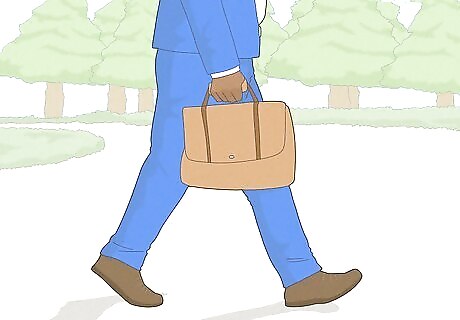
NEAT NEAT stands for Non-Exercise Activity Thermogenesis, and it refers to any type of physical activity you perform throughout the day, including the ones that aren’t “exercise.” For example, vacuuming your floor, walking to work, and playing with your kids are all great ways to stay active without “working out.” If finding time to exercise is a big ask, try to squeeze more NEAT into your day to stay active. Just taking more time to walk can give you some much needed energy as well. Sometimes it can be overwhelming to commit to an hour of warming up, stretching, and exercising every day, but you might find it easier to commit to 3 15-minute walks a day. They might not seem like much in the moment, but they add up!
Dietary & Lifestyle Changes

Eat fewer calories. Exercise can help you lose weight, but it works best when combined with dietary changes. Drastically eliminating calories is not a healthy or sustainable option, so don’t cut back too much. To ensure you get enough food and that you don’t give up on your diet, try to intake about 500 fewer calories a day—no more than that. The average person needs about 2000 calories a day to maintain their weight, so to lose weight, try to get about 1500 a day—the minimum amount a man needs to stay healthy while still losing weight. The simplest way to cut calories from your diet is by cutting back on refined sugars and processed foods—so less cake and potato chips, more fruits, veggies, whole grains, and lean proteins. Food tracker apps like Lifesum or My Fitness Pal can help you stay on top of what you’re eating from day to day, and they can even track your daily workouts.
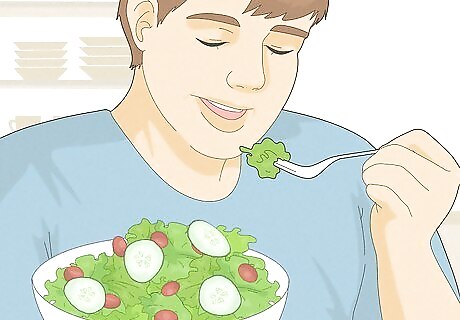
Practice mindful eating. Just going into your meals with a mindful attitude has been proven to positively affect what and how much we eat, as well as to enhance the eating experience. Mindful eating prioritizes focusing on the experience of eating—the physical, emotional, and mental sensations, what the food tastes like, and what your body is craving. In fact, for many people, counting calories can lead to unnecessary caloric restriction—which usually isn’t sustainable and can cause you to “boomerang” right back into unhealthy eating habits. Mindful eating is also a great way to approach healthy eating: instead of treating eating healthy as “dieting” or depriving yourself of the things you love to eat, mindful eating requires that you become more in tune with your food and your body, which ultimately can make the experience of eating more pleasurable.
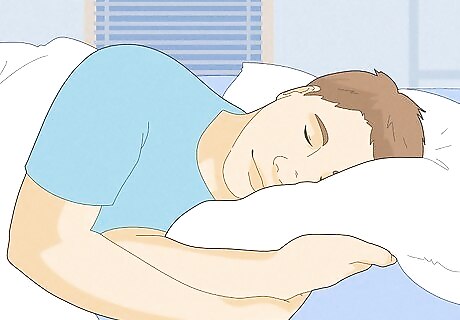
Get better sleep. We all know quality sleep makes a big difference in our lives, yet so few of us actually get an adequate 40 winks! Adults need somewhere between 7 and 9 hours of uninterrupted sleep each night in order to stay energized, focused, motivated, and happy during the day. Not getting enough sleep can make it harder to control your appetite, causing you to overeat (and more likely than not, it’s not vegetables you’ll be chowing down on). Lack of sleep can also make it harder to find the energy and willpower to exercise. To ensure you get a good night’s sleep, turn off all screens at least an hour before bedtime, especially those with blue light, which has been proven to negatively affect sleep.
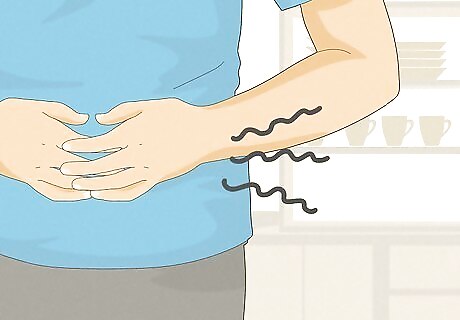
Watch your stress levels. Stress is one of the biggest factors in overeating. Mindful eating can help you “eat your feelings” less, but so can just managing your stress levels. Take time every day for activities that help you breathe, relax, and slow down—your stomach will thank you. Doing yoga is a great way to unwind and destress. Consider taking a class in your area, or check out YouTube’s wide assortment of yoga videos for all levels. If you find it difficult to destress on your own, consider talking to friends for support, or reach out to a licensed therapist. A little venting and talking things through can work wonders on your mood and mental health.
Medical Procedures to Reduce Groin Fat
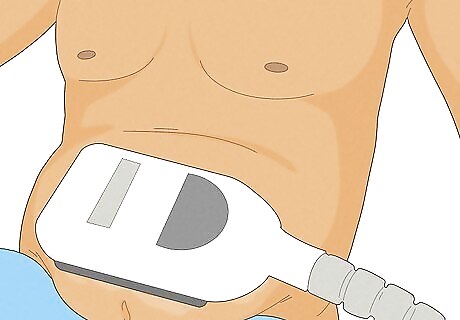
Cryolipolysis If you want to bypass exercise and lifestyle changes, or if changing your routine doesn’t seem to be working, there are a few medical options that could help. Cryolipolysis—a.k.a. fat-freezing, or CoolSculpting—is a non-invasive method of fat removal during which the fat cells are frozen using a handheld device applied to the skin. The cells then die and, in the months following treatment, they’re sent to your body’s lymphatic system and filtered out as waste. Pricing varies depending on the amount of fat being treated, but expect to pay somewhere between $700 and $4500 for the procedure.
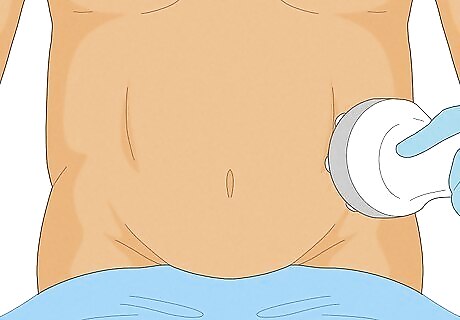
Nonsurgical fat reduction Another method of fat removal to consider before surgery is nonsurgical fat reduction. Nonsurgical fat reduction is sometimes called “nonsurgical liposuction,” but it’s not actually liposuction at all: it utilizes lasers, heat, cooling, or soundwaves to eliminate fat cells. Unlike with surgery, nonsurgical fat reduction usually requires little or no recovery time afterward, so you can lose your desired amount of weight and just keep right on keeping on. This form of treatment may be ideal for small areas of pesky fat that you just can’t seem to get rid of. For larger areas of fat, nonsurgical fat reduction may not work. Nonsurgical fat reduction can cost anywhere between $5000 and $15,000.
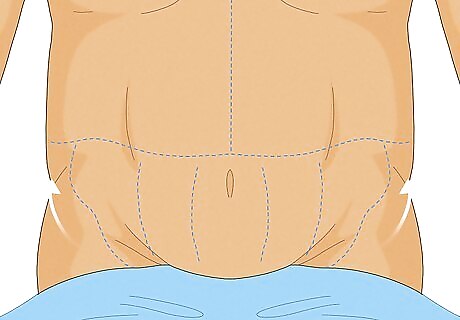
Surgery Surgery, such as Monsplasty, liposuction, abdominoplasty, and panniculectomy, may be the best route if you’ve got a large amount of fat you want to lose and if you’re having trouble losing it through exercise and dietary changes alone. Consult with your doctor about the best surgical option for you. A monsplasty, sometimes called a pubic lift, refers to surgery in which excess fat is removed from the pubic mound—that is, the upper portion of fat above your pubic area. It usually ranges from $2000 to $8000. Liposuction is a type of cosmetic surgery in which fat is removed from a specific part of the body (such as the groin) via suction. It can cost anywhere from $2000 to $4000. Abdominoplasty, also known as a tummy tuck, is a surgical procedure that’s a lot like liposuction, except that after the fat is removed, the excess skin is also removed. The average cost of a tummy tuck is about $6000. A panniculectomy is a bit like a monsplasty, except that the excess fat is surgically removed from the lower pubic region. The cost depends on the surgeon and how much fat you’re removing, but expect to pay anywhere from $8000 to $15,000.
















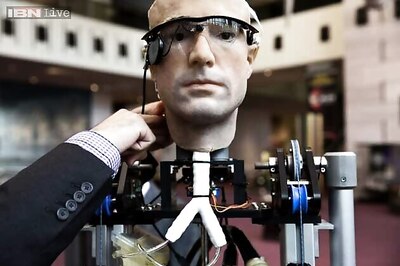


Comments
0 comment